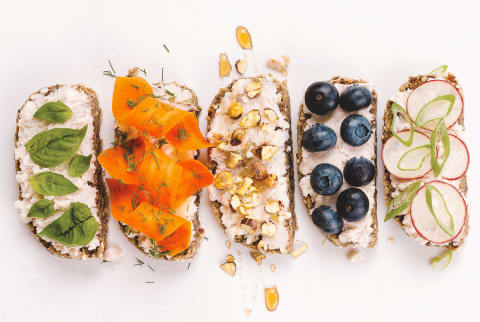How To Make Your Own Plant-Based Ricotta


It's less complicated than you'd think to make plant-based cheese at home—it turns out the one thing you really need is patience.
This almond ricotta is a perfect place to start with making your own plant-based alternatives since it requires only a few ingredients and can be used in sweet or savory dishes for any meal. The recipe comes from the new cookbook Plant-Powered Athlete, which shares ways to power your body with plants regardless of your activity level.
Advertisement
While they may sound synonymous, plant-based diets are actually different from vegan diets in a few ways. The primary difference is that while the vegan diet means not consuming any animal products and often eliminating animal-based products in life overall, a plant-based diet doesn't have to mean eliminating animal products entirely. Instead, it may mean considering them supporting foods or other levels of limitation in your diet. It also places the emphasis on whole foods, where the vegan diet may still include processed foods—so long as they're made without animal products.
"This almond ricotta provides loads of nutrition and makes a unique and versatile addition to your plant-powered meals," write authors Zuzana Fajkusova and Nikki Lefler in their introduction to this recipe, "This ricotta is creamy and slightly sweet in flavor, just like traditional ricotta!" Try serving it on toast with fresh veggies, or add a spoonful to your favorite healthy pasta for a creamy touch.
Almond Ricotta
Makes 2 cups
Advertisement
Ingredients
- 2 cups almonds, soaked in water for 2+ hours
- 1½ cups purified water
- 1 tsp. Celtic sea salt
- 1 to 2 probiotic capsules
Method
- Drain and peel the soaked almonds (see notes).
- In a high-speed blender, combine the purified water and salt, then add the almonds. Blend until smooth and creamy.
- Pour the mixture through a cheesecloth or nut milk bag and allow to drain for 4 hours or overnight.
- Transfer the drained mixture to a clean glass bowl or container. Break open the probiotic capsule(s), and, using a wooden or plastic spoon, gently stir it in.
- Cover with a clean towel and leave to ferment for 8 to 12 hours at room temperature. Use this timing as a basic range. The culturing process can go slower or quicker than expected, depending on the environment. Taste the cheese throughout the fermenting process to find the optimal flavor that you prefer. Be sure to use a clean spoon each time, so you don't contaminate the cheese.
- Once fermentation is complete, you can add other ingredients, such as lemon juice, garlic, freshly ground black pepper, herbs, sun-dried tomatoes, or even dried fruit.
- Store in the fridge in an airtight container for up to 2 weeks. The longer the cheese ages in the fridge, the tangier it will taste.
Advertisement
Notes:
- Removing the skin gives the almonds a smooth texture, which is helpful in making such dishes as this one. To begin, soak your almonds for 2 hours or overnight, drain and rinse well. Use your fingers to gently squeeze the almonds and loosen the skin from them. Once all almonds are peeled, rinse them again, and now they are blanched and ready to use in your recipe.
- The number of capsules you use will depend on the strength of the probiotic. The probiotic that we currently use for fermentation is Natren Megadophilus Dairy-Free Capsules, available at most natural food stores. However, you can use any brand that you have on hand.
Advertisement

Eliza Sullivan is an SEO Editor at mindbodygreen, where she writes about food, recipes, and nutrition—among other things. She received a B.S. in journalism and B.A. in english literature with honors from Boston University, and she has previously written for Boston Magazine, TheTaste.ie, and SUITCASE magazine.
